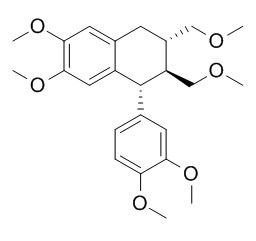Phyltetralin
Phyltetralin has antihyperuricemic activity.
Inquire / Order:
manager@chemfaces.com
Technical Inquiries:
service@chemfaces.com
Tel:
+86-27-84237783
Fax:
+86-27-84254680
Address:
1 Building, No. 83, CheCheng Rd., Wuhan Economic and Technological Development Zone, Wuhan, Hubei 430056, PRC
Providing storage is as stated on the product vial and the vial is kept tightly sealed, the product can be stored for up to
24 months(2-8C).
Wherever possible, you should prepare and use solutions on the same day. However, if you need to make up stock solutions in advance, we recommend that you store the solution as aliquots in tightly sealed vials at -20C. Generally, these will be useable for up to two weeks. Before use, and prior to opening the vial we recommend that you allow your product to equilibrate to room temperature for at least 1 hour.
Need more advice on solubility, usage and handling? Please email to: service@chemfaces.com
The packaging of the product may have turned upside down during transportation, resulting in the natural compounds adhering to the neck or cap of the vial. take the vial out of its packaging and gently shake to let the compounds fall to the bottom of the vial. for liquid products, centrifuge at 200-500 RPM to gather the liquid at the bottom of the vial. try to avoid loss or contamination during handling.
Pharmacognosy Magazine2018, 14(56):418-424
Geroscience.2024, 01207-y.
Phytomedicine.2023, 116:154841.
Cancers (Basel).2021, 13(6):1432.
J Cell Mol Med.2020, 24(21):12308-12317.
Separations2023, 10(2), 131.
Journal of Medicinal Food2023, Vol.26(10).
Plants (Basel).2022, 11(16):2126.
Metabolites.2023, 13(5):625.
Curr Issues Mol Biol.2023, 45(2):1587-1600.
Related and Featured Products
J Ethnopharmacol. 2008 Mar 5;116(2):333-40.
Anti-oxidant and inflammatory mediator's growth inhibitory effects of compounds isolated from Phyllanthus urinaria.[Pubmed:
18187278]
METHODS AND RESULTS:
Phyllanthus urinaria Linnea (Euphorbiaceae), is a traditional anti-hepatitis herb used in Taiwan. In continuation of our search for potent natural anti-inflammatory agents, from the ethanolic extract of this plant, nine compounds including phyllanthin (1), Phyltetralin (2), trimethyl-3,4-dehydrochebulate (3), methylgallate (4), and rhamnocitrin (5), methyl brevifolincarboxylate (6), beta-sitosterol-3-O-beta-d-glucopyranoside (7), quercitrin (8), and rutin (9) were isolated.
CONCLUSIONS:
The structures of compounds 3 and 6 were established based on NMR and mass spectral studies. The isolates 1-9 were investigated for their antioxidant, and anti-inflammatory activities in vitro.
Planta Med. 2006 Nov;72(14):1262-7. Epub 2006 Sep 1.
Antihyperuricemic lignans from the leaves of Phyllanthus niruri.[Pubmed:
16953466]
METHODS AND RESULTS:
The methanol extract from the leaves of Phyllanthus niruri L. showed oral antihyperuricemic activity in potassium oxonate- and uric acid-induced hyperuricemic rats.
Fractionation of the extract by resin chromatography led to the isolation of a less polar fraction which exhibited the highest reduction of plasma uric acid. Further antihyperuricemic-guided purification of the fraction afforded three lignans, phyllanthin (1), hypophyllanthin (2) and Phyltetralin (3), of which 1 significantly reversed the plasma uric acid level of hyperuricemic animals to its normal level in a dose-dependent manner, comparable to that of allopurinol, benzbromarone and probenecid which are used clinically for the treatment of hyperuricemia and gout.
CONCLUSIONS:
Thus, the lignans of P. niruri are potential antihyperuricemic agents worthy of further investigation.
Planta Med. 2006 Dec;72(15):1353-8. Epub 2006 Oct 20.
The cytotoxic effect and the multidrug resistance reversing action of lignans from Phyllanthus amarus.[Pubmed:
17054045]
Multidrug resistance (MDR) constitutes the major obstacle to the successful treatment of cancer. In several cancer cells, MDR is thought to be mediated by the super-expression of P-glycoprotein (Pgp). Pgp extrudes drugs from the cells, therefore reducing their cytotoxicity, and its activity inhibition may reverse the MDR phenotype. The present study evaluated the possible cytotoxic effect and MDR reversing properties of the extract and compounds isolated from Phyllanthus amarus. To this purpose, two human leukaemia cell lines were employed: K-562 and its vincristine-resistant counterpart Lucena-1, a Pgp-overexpressing subline.
METHODS AND RESULTS:
We report here that Lucena-1 was significantly more resistant to the cytotoxicity of P. amarus derivatives: the hexane extract (HE, 100 microg/mL), the lignans-rich fraction (LRF, 100 microg/mL) and the lignans nirtetralin (NIRT, 43.2 microg/mL), niranthin (NIRA, 43 microg/mL) or phyllanthin (PHYLLA, 43 microg/mL) exerted cytotoxic effects on K-562 cells with 40.3, 66.0, 62.0, 61.0 or 24.1% of cell death, respectively. The cellular toxicity observed on Lucena-1 was 16.3, 40.4, 29.4, 30.2, or 24.8%, respectively. However, cell treatment with the lignan Phyltetralin (PHYLT) up to 41.6 microg/mL had no cytotoxic action on either of the cell lines. P. amarus derivatives were also found to be effective in inhibiting Pgp activity as assessed by rhodamine accumulation in Lucena-1 cells, as were the classical Pgp inhibitors, cyclosporine A (160 nM), PSC-833 (2 microM) and verapamil (5 microM). The lignan NIRT produced the most potent inhibition (EC (50) = 29.4 microg/mL) followed by NIRA (44.3 microg/mL), LRF (49.1 microg/mL), PHYLT (99.4 microg/mL), PHYLLA and HE (> 100 microg/mL). Lucena-1 cells were more resistant to daunorubicin-induced cell death (LC (50) = 50 microM) than K562 cells (LC (50) = 4.95 microM). Of note, the P. amarus derivatives significantly potentiated 5 microM daunorubicin-induced cell death in Lucena-1 cells (P < 0.01) but not in K562 cells. After treatment only with P. amarus derivatives (100 microg/mL HE, 30 microg/mL LRF, 12.9 microg/mL NIRA, 43.2 microg/mL NIRT, 43 microg/mL PHYLLA or 41.6 microg/mL PHYLT), the Lucena-1 cellular viability was 83.7, 85.3, 101, 69.7, 75.6 or 88.7%, respectively, whereas the in the presence of daunorubincin, which was not cytotoxic PER SE, the cell viability decreased to 42.9, 42.2, 64.2, 35.4, 30.4 or 52.6%, respectively.
CONCLUSIONS:
Together, these results suggest a potential action of P. amarus derivatives as MDR reversing agents, mainly due to their ability to synergize with the action of conventional chemotherapeutics.



